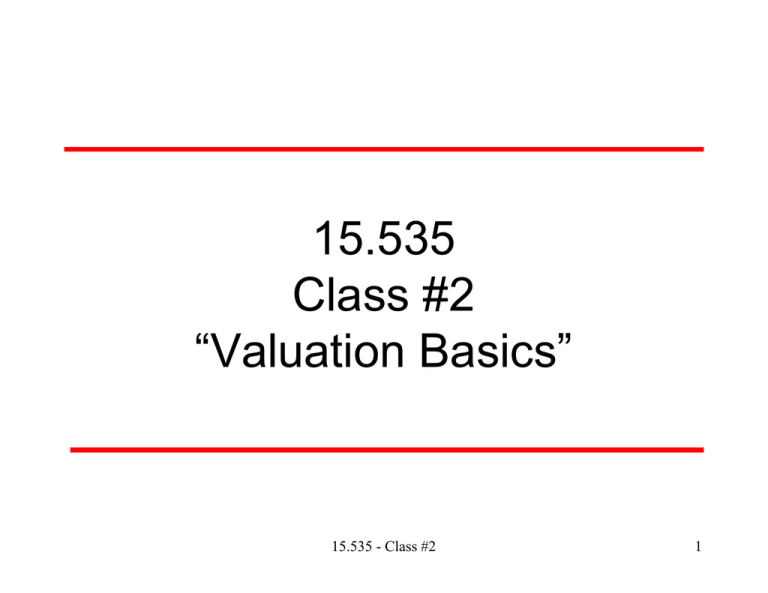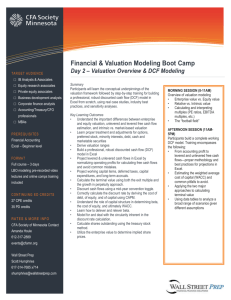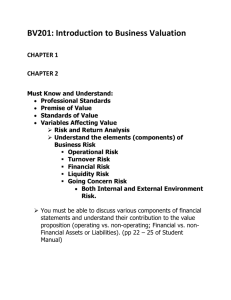Document 13616765
advertisement

15.535 Class #2 “Valuation Basics” 15.535 - Class #2 1 Homepage Address http://mit.edu/wysockip/www Or (Click on “Analysts”) Check here for examples of projects from prior years. 15.535 - Class #2 2 Where Next? • Readings for Class #2 (Today) – Review your Finance notes on DCF – Skim Section B of Course Pack: “Free Cash Flow to Equity Discount Models” (from Chapter 14 of Investment Valuation by Damodaran) • Readings for Class #3 (Tuesday) – Cash Flow Analysis – Skim Section D of Course Pack: “Income versus Cashflow” • Reminder to form teams for project 15.535 - Class #2 3 Recap From Last Class • Market Efficiency • Financial Statement Information used for: – Valuation – Contracting • Today – lay the groundwork for valuation – Take “baby steps” – by end of class will have basic tools to do a full-blown valuation 15.535 - Class #2 4 Firm Value and Future Cash Flows • The value of a firm (or shares in that firm) must be related to the (net) cash flows returned to owners of the firm. – If this is not true, then we have an arbitrage opportunity (money-making machine) • Expected future cash flows versus actual future cash flows 15.535 - Class #2 5 What is the source of flows? • As a first step, one must understand how firm will generate cash flows in the future! – Strategy, Economics, Marketing, Operations, etc. • Must appreciate competitive market forces: – If a company has a great idea that will generate huge profits, competitors soon will follow! – Barriers to entry, first-mover advantage, monopoly • How will Compaq generate its future sales, profits, cash flows? 15.535 - Class #2 6 DCF is fundamental to everything we will do in this course • Must understand DCF analysis! – When we perform any type of valuation analysis … It will always boil down to DCF! • P/E multiples, PEG ratios, price targets – These all are transformations of DCF. • Other factors things like real options are just extensions to basic DCF model! 15.535 - Class #2 7 Baby Step #1: “Simple PV” • Question: “How much would you be willing to pay to purchase 1 share in a company that will pay you a one-time cash flow of $100 to be paid (with no risk) in one year?” • PV = CF1/(1+r) – (Obtain “r” from http://research.stlouisfed.org/fred/data/irates.html • PV = $100/(1+0.0136) • PV = $98.66 15.535 - Class #2 8 Present Value of Free Cash Flows • If you could buy shares in this firm for less than $98.66, what would you do? • If the price of the shares is more than $98.66, what would you do? • People are greedy (which is good)! While markets may not be perfectly efficient, they are certainly competitive! 15.535 - Class #2 9 PV - Fundamental part of Valuation • PVToday=E(CF1)/(1+r) – This simple version of general DCF analysis says it all … and it it really simple … all we need to do is: • 1) Estimate future cash flows • 2) Estimate discount rate (future risk) • Where do we get future cash flows (crystal ball?) – Financial statements! • Where do we get estimate of future risk? 15.535 - Class #2 10 Baby Step #2: Future CF and Risk • What is the present value of a one-time riskless cash flow of $100 to be paid in two years (Assume r=1.36%)? • PV = CF/(1+r)2 = 100/(1+0.0136)2 = $97.33 • What if we are not certain that we will receive exactly $100 two years from now? • Use a higher discount rate • Systematic risk is only relevant! • CAPM – Discount rate only determined by nondiversifiable risk. 15.535 - Class #2 11 Baby Step #3: Many CF’s • What if the firm will generate many cash flows at different times in the future? • PV = CF1/(1+r)+CF2/(1+r)2+CF3/(1+r)3+… • Example: Calculate the present value of three $10 cash flows paid at end of year 1, year 2 and year 3. Assume discount rate of 10%. • PV = 10/(1.10)+10/(1.10)2+10/(1.10)3 • PV = 9.09 + 8.26 + 7.51 = $24.86 15.535 - Class #2 12 Baby Step #4: Perpetuity • What if we received $10 a year indefinitely? Seems like a lot of work …. • PV = CF1/(1+r)+CF2/(1+r)2+CF3/(1+r)3+… • Formula for perpetuity: PV = P = CF/r • Check back of today’s handouts for a “proof” of this nifty formula. • Useful for calculating “terminal values” 15.535 - Class #2 13 Quick Aside: P/E ratios • As a preview to topic on “Comparative Analysis” (Class #5), we can see that P/E Ratio is really just a DCF formula! • As a first approximation, accounting can be thought of a proxy for net cash flows available to shareholders. • What if firm will generate constant Earnings = Cashflows in the future? 15.535 - Class #2 14 P/E ratios example • Perpetuity Formula: • P = CF/r = E/r • CF= Free Cash flows, E = Earnings • Therefore, re-arrange to get: • P/E = 1/r • What is the P/E ratio of a stock randomly picked from the S&P 500? 15.535 - Class #2 15 Baby Step #5: Growing Perpetuity • It seems a little extreme to assume that cash flows will be constant forever. • Why might cash flows grow in the future? – These are nominal amounts. – The discount rate also takes into account inflation. 15.535 - Class #2 16 Value of Growing Perpetuity • Example: Calculate the present value of a cash flow stream that starts at $10 one year from today, and then grows at a rate of 5% per year thereafter. Assume discount rate of 12%. • PV = CF/(r-g) • PV = 10/(0.12-0.05) • PV = $142.86 • Warnings!!! 15.535 - Class #2 17 After just just 5 baby steps! • Single cash flow: • PV = CF1/(1+r) • Single cash flow in “n” years from now: • PV = CFn/(1+r)n • Multiple cash flows in future: • PV = CF1/(1+r)+CF2/(1+r)2+CF3/(1+r)3+… • Perpetuity of fixed cash flows: • PV = CF/r (1st CF is at the end of year 1!) • Growing Perpetuity: • PV = CF/(r-g) (1st CF at end of year 1, then grow at g) • Understanding P/E ratio (just restating DCF!) 15.535 - Class #2 18 Warnings!!! • Always draw a time-line for yourself and label the cashflows! – Know when they occur (beginning/end of period) – Make sure discount rate and growth rates are reasonable! – Growing perpetuity: • Discount rate “r” must be larger than cash flow growth rate. Otherwise you will get garbage. 15.535 - Class #2 19 PV of what? Equity or Enterprise? • Equityholders? (i.e. shareholders) Valuation goal is often to determine price of 1 share: – Equityholders are residual claimants. – They receive the “leftover” cash after paying who? • All Investors? (Shareholders and Lenders)? – Known as “Enterprise Value” • DCF looks the same: PV = CF/(1+r), but • CF’s are usually different for equity versus enterprise. • Risk is different. 15.535 - Class #2 20 Valuation • 1) Equity valuation: – Forecast free cash flows available to equity. – Discount expected cash flows by the cost of equity capital. • 2) Enterprise (firm or asset) valuation: – Forecast cash flows available to all providers of capital (debt and equity). – Discount expected cash flows by weighted average cost of (debt and equity) capital – Can get equity value by subtracting value of debt. – Widely used in practice. 15.535 - Class #2 21 General Valuation Approach: • First: Forecast cashflows over finite horizon (usually 5 to 10 years), final year is terminal year. • Second: Forecast cashflows beyond terminal year (invoke assumptions) • Third: Discount by appropriate cost of capital (if Enterprise, then WACC) • Fourth: (if using Enterprise valuation): Subtract estimated market value of debt to get current estimate of equity value 15.535 - Class #2 22 Forecasting CF’s • Not as easy as it might appear! This is where analysts earn their keep! • We will spend a whole class on this topic. • Key issue is that we need to find “free cash flow” that is leftover for investors. – Some analysts forecast EBITDA to keep it simple, but this is a simply an approximation. 15.535 - Class #2 23 Examples: DCF Valuation • “Back of the envelope” valuation of Compaq Computer using: 1) Equity Valuation - Use analysts’ estimates of earnings to help us get future cash flow estimates Use CAPM to get estimate of “r” 2) Enterprise valuation - Similar approach, but value CF’s available to all investors. 15.535 - Class #2 24 Method #1: Equity Valuation • Step 1: Forecast earnings for the future – Often difficult to directly forecast free cash flows. – Where can we get quick estimates of future CF’s? – Let’s forecast earnings: Analysts’ forecast earnings – But, earnings are NOT cash flows! • Step 2: Adjust earnings (net income) to get free cash flow to equity: Free Cash Flow to Equity = Net Income – (CapEx – Depreciation) – Working capital Accruals + (New debt issued – Debt Repayment) 15.535 - Class #2 25 Equity Valuation continued • Step 3: Forecast capex, depreciation, working capital accruals, & debt transactions – PROBLEMS: Investment and debt issuance are often lumpy! What does depreciation tell us? – A useful simplification for quick and dirty analysis: • Assume future average CapEx=Depreciation • Assume constant average debt (Issue=Repay) • Steady state working capital accruals average to zero. – Therefore, Free Cash Flow to Equity = Net Income – In next class, we will spend time doing detailed calculation of projected free cash flow. 15.535 - Class #2 26 Equity Valuation Continued • Step 4: Calculate the PV of equity cashflows: – – – – Years 1-4 are easy! Year 5 & beyond: Use our “special formulas”. PV = CF/r OR PV = CF/(r-g) WARNING: This is the “present value standing in year 4”! This “terminal value” that must be discounted back to the present 15.535 - Class #2 27 Equity Valuation: Compaq Computer • Step 1: Use analysts’ earnings forecasts from Yahoo! Finance – EPS(Year ended Jan. 2003) = $1.78 – EPS(Year ended Jan. 2004) = $2.04 – 5 year average growth forecast = 14% – EPS(2005) = EPS(2004) *1.14 = $2.33 – EPS(2006) = EPS(2005) *1.15 = $2.65 – EPS(2007) = EPS(2006) *1.15 = $3.02 – What about 2006 and beyond? Assume growth rate based on understanding of economics! 15.535 - Class #2 28 Equity Valuation: Compaq Computer • Step 2: Adjust Earnings to get Free Cash Flow: – Quick and dirty assumption 1: Working Capital Accruals equals zero – Quick and dirty assumption 2: Depreciation equals long-run capital reinvestment – Quick and dirty assumption 3: Average debt issued = debt repayments • Step 4: Calculate PV of all cash flows – Today, we will use CAPM 15.535 - Class #2 29 Enterprise Valuation: Compaq Computer • The alternate method is Enterprise Valuation. • If Firm has no debt, then just apply the straightforward equity valuation method. • However, if firm has debt, then we want to create an “What if” scenario: “What if the firm had no debt?” 15.535 - Class #2 30 Enterprise Valuation: Compaq Computer • RESULT: Steps 1 and 2 are the same. • New Step 3: Forecast after-tax net interest payments. • New Step 4: Calculate cash flows for unlevered firm. • New Step 5: Discount cash flows using WACC. 15.535 - Class #2 31 Review Examples in Coursepack • See example valuations in Coursepack (Section B – “Free Cash Flow to Equity Discount Models” – Ch 14 of Damodaran) – Singapore Airlines: Page 360-361 – Nestle: Pages 365-367 – Tsingtao Breweries: Pages 370-372 • Note that each case is just a based on the simple ideas we discussed in class today! • Reading for next class: Skim pages 69-88 of Section D of Course Pack: “Income versus Cashflow” (from Financial Reporting and Statement Analysis Stickney and Brown) 15.535 - Class #2 32







